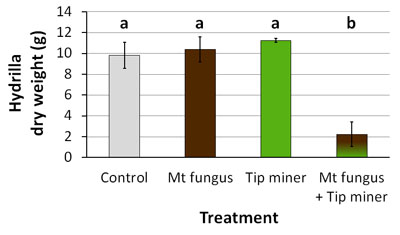|
We have exciting new research results to share with you.
As you know, the herbivorous hydrilla tip miner and the Mt fungus, a specialist hydrilla pathogen, occur naturally in the United States and have shown potential as biological control agents of hydrilla. Hence, we tested how these organisms would affect hydrilla biomass production when used in combination with each other.
Results from our short-term aquarium experiments show that the tip miner is compatible with the Mt fungus. Moreover, within only 28 days, a synergistic effect was seen. The combined treatment with a high dose of Mt and a low density of tip miner larvae significantly reduced hydrilla biomass by almost 80% when compared with the untreated control.
It is important to note that careful selection of dosages seems necessary to achieve this effect.

The above figure shows hydrilla biomass (dry weight) 28 days after application of the Mt fungus and/or the tip miner in 55-Liter aquariums. Controls received no treatment. Different letters indicate statistically significant differences when compared with the control (ANOVA and Fisher’s LSD test, alpha<0.05).
Experiments were conducted at the U.S. Army Engineer Research and Development Center (ERDC) in Vicksburg, MS.
As always, we acknowledge the funding provided by the U.S. Department of Agriculture, National Institute of Food and Agriculture, Risk Avoidance and Mitigation Program (grant 2010-02825).
|